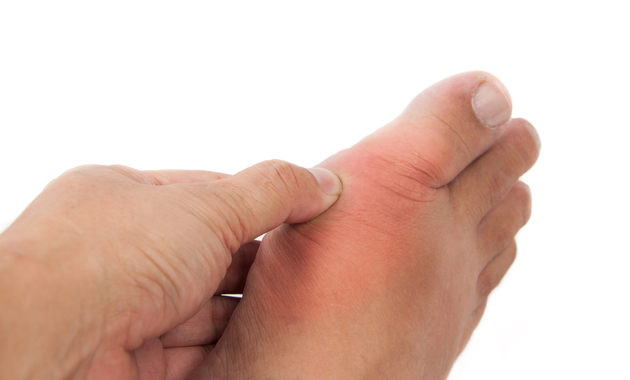
Gout, as you might be aware of, causes sudden attacks of pain in the joints. It usually affects the big toe, but can affect any joint. Gout causes the joints to become painful and swollen with the skin turning red. In most cases, a gout attack if not treated can also increase the risk of skin ulcers, sore joints, joint stiffness, and kidney stones. However, gout can be managed and even prevented by following a few simple lifestyle changes along with taking medicines. Here are some tips on gout treatment and how to manage it at home.
Gout Treatment: Tips To Manage Gout At Home
Diet and medicines are the key tips that can help lower the level of uric acid in the blood and avoid gout attacks, thereby helping you to manage gout at home. Here are a few tips to follow:
1. Maintain a healthy weight
If you are overweight and suffering from gout, then one of the effective ways for gout management is to lose weight. It is important to keep your weight under control as excess weight can trigger a gout attack and prolong the recovery with treatment. Being overweight may increase the amount of uric acid in the blood, which in turn causes gout. Hence, try to shed weight and maintain a healthy weight to manage and prevent gout.
However, drastic weight loss or losing more than a kg per month is not recommended. According to a 2008 study published in the American Journal of Clinical Nutrition[1], weight loss of less than 1 kg/month with light physical exercise is desirable for people suffering from gout. And the more rapid loss of weight could lead to ketoacidosis, which in turn can also trigger a gout attack.
Weight Loss Is 99% Mental And 1% Physical. Start Your Journey Today. Click Here.
2. Avoid foods that trigger gout attack
There are certain foods that can trigger a gout attack. Taking note of such foods can help you to avoid these foods or limit the intake of these foods in the diet. For example, non-vegetarian foods such as meat, chicken, and seafood can cause gout attacks because they contain lots of protein, which produces uric acid on digestion. Hence, it is advised to enjoy no more than two small servings of meat, chicken, or seafood each day.
You can even replace these foods with beans, peas, lentils, and tofu as they contain less protein. Moreover, having two servings of low-fat dairy foods such as milk, low-fat cheese or yoghurt on a daily basis can help protect you against gout.
Click here to know about the uric acid test for gout diagnosis. Book a test online.
3. Drink plenty of water
Try to drink at least 2 litres of water or other non-alcoholic drinks every day. You should drink more if you have kidney stones. According to a 2009 study[2], patients with a history of kidney stones are recommended to drink more than 2 litres of water every day. You should also limit the consumption of fructose-containing drinks (i.e., sugar-sweetened soft drinks) as these reduce the excretion of uric acid and increase the risk of gout attacks.
Alcohol should be limited if you are having frequent gout attacks. Beer has high purine content which can increase uric acid level in the body. So, drink more water and say no to alcohol, to manage and prevent gout.
4. Remember to take your medicines
Most people suffering from gout are prescribed medicines to reduce the level of uric acid and prevent gout attacks. Once you start taking these medicines, it is advised that you should keep taking medicine every day, even when you feel well. Do not stop the medicines without consulting your doctor. If you experience severe pain, go to your doctor.
Avoid taking over-the-counter painkillers as these medicines might not be good enough to relieve the pain caused due to gout. Never take medicine which is prescribed for someone else as it might not show the same results for you. If the pain still fails to subside, see your doctor immediately.
**Consult India’s best doctors here**
5. Try home care tips to manage and prevent pain
Apply an ice pack to the painful joint as it can improve pain and inflammation. If you do not have an ice pack at home, you can simply add a few ice cubes in a cotton cloth and apply it on the affected area for 20- 30 minutes, several times a day.
You can even elevate your foot, if the foot is affected, with the help of a pillow on a bed as it helps to reduce swelling. In some cases, even the weight of the bedsheets and blankets can cause unbearable pain to the inflamed toe. Hence, it is best to tame your bedsheets. Also avoid wearing socks, shoes or slippers as it can further worsen the pain.
Follow these simple tips as it not only acts as an effective gout treatment but also helps you to manage the symptoms at the comfort of your home. But always remember to consult a doctor if you feel severe pain or if there are any skin changes around the area of inflammation to get it treated on time.
(The article is reviewed by Dr. Swati Mishra, Medical Editor)
Recommended Reads:
Gout: Causes, Symptoms And Treatment
References:
1. Williams PT. Effects of diet, physical activity and performance, and body weight on incident gout in ostensibly healthy, vigorously active men. Am J Clin Nutr. 2008 May;87(5):1480-7.
2. Tausche AK, Jansen TL, Schröder HE, Bornstein SR, Aringer M, Müller-Ladner U. Gout–current diagnosis and treatment. Dtsch Arztebl Int. 2009 Aug;106(34-35):549-55.
3. Managing a Gout Attack. Understanding Arthritis. Arthritis Foundation.